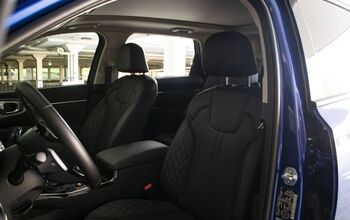Kia Carnival vs Toyota Sienna Comparison: Hybrid Haulin’

There aren’t a whole lot of minivans left on the market: just four traditional ones, really.
There’s the swanky Chrysler Pacifica (and its discount Voyager twin—okay, 4.5 minivans). The enduring and traditional Honda Odyssey. Then there are these two: the hybrid-only Toyota Sienna and the affordable Kia Carnival. This year the Korean brand has dropped its own hybrid system into its big box on wheels, and thus the latest AutoGuide comparison was born.
Quick Take
Even if the word “minivan” still scares some folks, there’s no arguing that they’re the ultimate family vehicle. Can the newly electrified Carnival out-minivan the Prius of the segment, the Toyota Sienna? Not in all the ways—but it still has a major value advantage.
2025 Kia Carnival Hybrid SX Prestige: All The Details
What’s New for 2025:
Kia Carnival: After the model’s facelift last year—which saw visual changes along with a bump in tech—the Carnival gains this new hybrid variant for 2025. This isn’t just a direct drop-in from the likes of the Sportage or Sorento, either: Kia has embiggened the battery and electric motor for big box duty. The motor makes 72 horsepower on its own, and combined system horsepower hits 242 hp. While that’s down on the V6, torque is up to a class-leading 271 pound-feet.
2025 Toyota Sienna Platinum AWD: All The Details
Toyota Sienna: Toyota’s minivan also came in for a facelift this year, though you’d be hard-pressed to tell. There’s not much new outside, save a new gray paint and wheel designs on the Woodland Edition and this top-shelf Platinum. There are trim changes inside, and the vacuum and fridge that were originally planned for this generation have finally showed up. More standard safety kit is part of the package, while the hybrid powertrain—the only option with the Sienna—remains unchanged.
Exterior Style:
Carnival: Kia’s big box came in for a facelift last year, grafting on a more angular, EV9-like face to lean even further into SUV looks. There are changes out back as well, with the outer edges of the light bar sprouting arrow-shaped additions, while the Kia badge migrates south. The Dark Edition package available on this SX does what it says, shading various trim pieces on the exterior along with the 19-inch alloys.
“The Carnival is trying hard not to look like a minivan, and it partially succeeds. It has a more rugged, SUV-like appearance compared to the Sienna,” notes Schlee. “I really like the dark red color it came in, which is available on the top trim in Canada, but only the second-highest trim in the USA.”
Sienna: This generation Sienna has just a hint of Bōsōzoku about it in its swept-back greenhouse and pronounced fender flares. Subtle it ain’t, although this Platinum trim is trying its best to be, with the nondescript silver paint rendering it basically invisible in traffic. Mike and I are split on the wheel design: I think it’s expressive, while he can’t shake the thought of early-aughts AutoZone specials. Toyota’s excellent Cypress color would do this design a whole lot of favors…
Powertrain and Fuel Economy:
Carnival: For those who haven’t yet experienced a hybrid, the Carnival’s turbo setup is a good introduction. Since it features plenty of low-down torque and a traditional six-speed automatic, it delivers power in a very “normal” way. Both vehicles are responsive, and while they do make a racket in full throttle applications, it’s the Carnival that is quieter. It’s not necessarily quicker, mind you: the Kia hauls around more weight, so these two are essentially tied for hustle.
It might look even more SUV-like, but the Carnival remains a front-drive-only affair. Despite this, it can’t quite match the all-wheel-drive Sienna’s fuel economy. It gets close in the city, where it officially scores 34 mpg (6.9 L/100 km). Its highway score is significantly worse however at 31 mpg (7.6 L/100 km), which is still excellent for something this size. Nonetheless, its 33 mpg (7.2 L/100 km) combined figure is the worse figure in this face-off, and there was no hope of matching it during the worst snow storm of the year.
Sienna: Toyota’s hybrid powertrains are a known quantity now: easy to judge, great on gas, and oh-so noisy. This setup has a whole three horsepower more than the Carnival and an additional motor operating solely on the rear axle, though if there is a performance advantage, it is very slight. The Sienna’s 2.5-liter engine is a grumbly Gus, and it is pressed into action more often than the Carnival’s smaller turbo-four.
Despite that, the Sienna still wins out on fuel economy, at least officially: 35 mpg city, 36 mpg highway, and 35 mpg combined. (Canadian equivalents: 6.8, 6.7, and 6.8 L/100 km, respectively.)
Handling and Drivability:
Carnival: “Neither van is going to light one’s soul on fire behind the wheel, nor are they meant to,” writes Schlee, adding “the Carnival is a bit more ponderous to operate, which may be purposeful to reflect the driving experience of a SUV.” We’re on the same wavelength. In a strange way, both the Carnival and Sienna like their equivalent platform-mates, the Telluride and Highlander. The Carnival is very deliberate in its movements, never letting its driver forget that they are piloting a large box through the city or down the highway. Thankfully sight lines are good, so it’s never hard to judge.
Since I spent more time in the Carnival during the snowstorm, I discovered some lack of polish in its winter-weather manners. Its traction control light flashed far more frequently, with more surging as the gas engine would come on in slippery conditions. On one instance it also struggled for grip on the wet concrete heading out of my underground parking. Of course, this could be chalked up to the fitted winter tires.
I need to call out the Carnival’s adjustable regenerative braking as well. This is an unusual feature on regular hybrids, typically reserved for plug-ins or full EVs, so it’s nice to have three levels available here. There isn’t much between them however, and the most aggressive setting has an odd pause before really decelerating, making it hard to judge.
Ride Quality and Comfort:
Carnival: That SUV-like driving experience translates to a relaxing ride in the Carnival. The Kia handles speed bumps better than its Japanese competitor, settling quicker. Conversely, it leans more in corners, and despite extra sound-deadening upgrades in the top trim, the Carnival lets in more road and wind noise.
Both vans’ front rows are comfortable with a wide range of adjustments, though the Kia’s tilt-and-telescoping steering wheel is a fully manual affair. In this top trim, the Kia suffers from a relative lack of headroom in the middle row due to second sunroof. As nice as those full-recline seats can be for folks, they do seriously impact the usability of the cabin. They’re heavy, to start—don’t expect kids to be able to slide them around easily—and they don’t move out of the way for access to the way back, making the only option shifting them outboard to pass between. The third row is generally good, though it feels dark due to the enormous C-pillar.
Sienna: “The Sienna has the more comfortable second-row captain’s chairs and more headroom too,” opines Mike, which is a welcome surprise, as typically we find Toyotas tight in their second rows. While he’s back there, Schlee points out that while both minivans have flip-up footrests, only the Kia’s is power-operated. In fact, the Sienna’s second row isn’t power-operated either, nor does it have ventilation. At least the climate controls are accessible for both passengers; the Kia’s are on the right side of the headliner. The third row is another set of trade-offs: a short squab makes it seem like there’s more legroom, and while there are cupholders on both sides, only the right-side rider gets access to the USB ports.
The Sienna’s ride is just a little stiffer than the Carnival’s. This manifests most noticeably on speed bumps, where there’s more pogoing. On the flip side, the Sienna stays flatter and calmer through corners.
Interior Style and Quality:
Carnival: The Carnival’s cabin is easily the more modern feeling, with clean surfacing and a distinct lack of faux wood. Thin vents, ample ambient lighting, some funky textures: it’s clear Kia is targeting younger folks here. We aren’t fans of the gratuitous amounts of piano black along the dashboard and (especially) the door panels however, which feels cheap. We do appreciate the light headliner however, which adds to the sense of spaciousness.
Sienna: Toyota has kept the Sienna cabin fairly traditional, with a dual-level dashboard design that is pleasant but hardly daring. Fit and finish is generally good, though there are some surprisingly chintzy bits of plastic here and there, such as the dashboard shelf that houses the wireless charger.
But here’s the thing: the Toyota is laid out so much better for family duty. There’s that easy-access shelf for starters, and a larger center console cubby, even with the vacuum. The bridge-like console also allows for a large storage spot between the front row seats, enough for a purse or even small laptop bag.
Tech and Safety:
Carnival: Kias are typically well-stocked, and this top-line Carnival is no exception. “The Carnival … has ventilated second row seats, and double insulated glass to keep road and wind noise to a minimum,” notes Schlee—not that the insulation seems to help as much as we’d like.
Both vans come with a large list of standard safety kit and driver assists, including useful bits like a surround-view monitor and blind spot detection. The Kia has Highway Drive Assist 2, which can take the sting out of long schleps, but it’s not as if the Toyota system is much different.
Kia’s latest infotainment is largely easy to use, though as before, it’s a fashion-over-function setup, so it can require more attention to get to the specific menu you’d want, instead of a quick glance. The swappable touch-sensitive controls below it are still just extra work. The large, 11.0-inch head-up display is a welcome addition.
Sienna: The Toyota’s big differentiators include its built-in fridge, vacuum, and entertainment screen. The latter can accept HDMI inputs too, so there’s nothing stopping you from bringing a gaming console along on road trips. Both vans have digital rearview mirrors, and it’s especially useful in the Sienna because of this screen.
The current Toyota infotainment system is bright and easy to use. It’s a little too simple sometimes, and its trip computer is odd, but wireless Apple CarPlay and Android Auto are a cinch to set up.
Value Dollars and Sense:
Carnival: The hybrid powertrain adds a couple of grand to the bottom line of the Kia, but you’re still looking at an exceptional $54,335 ($58,795 CAD) including destination for this SX Prestige model (SX+ in Canada).
Sienna: In America, the Toyota lists for $59,970 including destination. That’s over five grand more than the Kia, but considering how much better optimized the Toyota is for the daily grind, plus the AWD and better efficiency, we can justify that stretch.
Not so in Canada. For reasons unknown to us, this Platinum tester rings in at a slightly frightening $72,608 CAD with destination. That is nearly $14,000 more than the Kia.
Final Thoughts:
After a week of adventure with these two, through one of the worst snowstorms the region had seen, a few things became clearer. Toyota has been refining the Sienna for decades, and it still sets the bar for a useful, fuel-efficient minivan. For those who need a minivan and want one, it’s great. But boy oh boy will you pay for it, especially in Canada. Conversely, the Carnival is for those who need a minivan but don’t want one, because it looks—and drives—more like a modern SUV.
Become an AutoGuide insider. Get the latest from the automotive world first by subscribing to our newsletter here.
Kia Carnival Hybrid SX Prestige (SX+) | Toyota Sienna Platinum AWD | |
|---|---|---|
Powertrain | 8 / 10 | 8 / 10 |
Efficiency | 8 / 10 | 9 / 10 |
Handling and Drivability | 6 / 10 | 7 / 10 |
Passenger Comfort | 9 / 10 | 10 / 10 |
Ride Quality | 4 / 5 | 4 / 5 |
Exterior Style | 4 / 5 | 3 / 5 |
Interior Style and Quality | 8 / 10 | 7 / 10 |
Infotainment | 8 / 10 | 8 / 10 |
Cargo Capacity and Towing | 5 / 5 | 5 / 5 |
Safety | 4 / 5 | 4 / 5 |
Value | 8 / 10 | 7 / 10 |
Emotional Appeal | 6 / 10 | 6 / 10 |
TOTAL | 78 / 100 | 78 / 100 |
Kia Carnival Hybrid SX Prestige (SX+) | Toyota Sienna Platinum AWD | |
Engine/Motor | 1.6L I4 Turbo w/ hybrid | 2.5L I4 w/ hybrid |
Output: | 242 hp, 271 lb-ft | 245 hp |
Drivetrain: | FWD | e-AWD |
Transmission: | 6AT | e-CVT |
US Fuel Economy (mpg): | 35/36/35 | 34/31/33 |
CAN Fuel Economy (L/100 km): | 6.8/6.7/6.8 | 6.9/7.6/7.2 |
Starting Price (USD) | $42,235 (inc. dest.) | $40,635 (inc. dest.) |
As-Tested Price (USD) | $54,335 (inc. dest.) | $59,970 (inc. dest.) |
Starting Price (CAD) | $48,645 (inc. dest.) | $50,030 (inc. dest.) |
As-Tested Price (CAD) | $58,795 (inc. dest.) | $72,608 (inc. dest.) |

Kyle began his automotive obsession before he even started school, courtesy of a remote control Porsche and various LEGO sets. He later studied advertising and graphic design at Humber College, which led him to writing about cars (both real and digital). He is now a proud member of the Automobile Journalists Association of Canada (AJAC), where he was the Journalist of the Year runner-up for 2021.
More by Kyle Patrick
















































Comments
Join the conversation